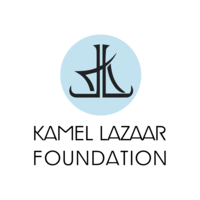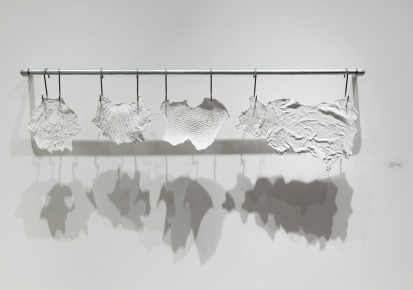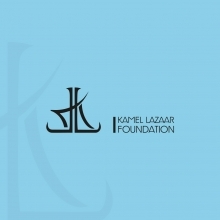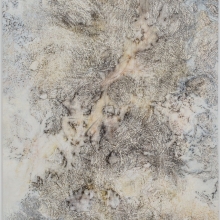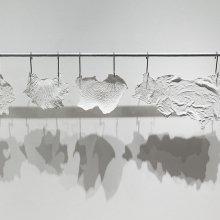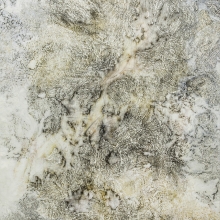Nadia KAABI-LINKE (Tunis - Tunisia, 1978).
Lives and works in Berlin, Germany.
Nadia Kaabi-Linke raised in Tunisia and the United Arab Emirates. She graduated from the University of Fine Arts, Tunis, in 1999, and earned a Ph.D. at Université Paris-Sorbonne, in 2008. Growing up between Tunis, Kyiv, and Dubai, and now residing in Berlin, Kaabi-Linke has a personal history of migration across cultures and borders that has greatly influenced her work. Her works give physical presence to that which tends to remain invisible, be it people, structures, or the geopolitical forces that shape them.
Using a variety of materials and methods, Kaabi-Linke often works in-situ on projects that relate directly to their exhibition sites. She has rendered visible the bodily traces of people waiting at Berlin bus shelters and subway stations, the scars of domestic violence victims in London, and paint chips scraped from city walls throughout North Africa and Europe. Between 2011 and 2014, she realized Meinstein, a permanent public artwork in Berlin that reflects processes of ethnic segregation. For her recent installation, “Walk the Line” (2015), volunteers wrapped two poles with thread the length of the Texas-Mexico border until it formed a dense wall. Flying Carpets (2011), which was shown at the Venice Biennale that year, gives physical shape to the immigrant merchants of Venice who often display their wares on sheets that they can be quickly swept up upon the arrival of authorities. Mapping the movements of the vendors and their blankets on a single bridge, Kaabi-Linke recreated the forms in steel, aluminum, and thread, suspending them above the viewer.
Border crossings of many kinds—European and North African, Islamic and Christian, East and West Berlin—have often served as the impetus for Kaabi-Linke’s endeavors. In No (2012), for example, a two-channel video work commissioned by the Liverpool Biennial, she reflects on the absurd difficulties of her own application as a Tunisian for entry into the United Kingdom in order to deliver a lecture, with a pair of disembodied lips reciting the accusatory questions found on British visa application forms as a crowd of churchgoers opposes the voice of authority in unison.
Nadia Kaabi-Linke has often payed an interest in bodies of builidings and their shifting nuances. How graffiti or injuries becomes new historical layers. In the work Impunities, the same precise methods for mapping are used, but this time it is the scars or bruises of people that are put into light. Kaabi-Linke uses forensic methods and here the imprints have been etched into glass. They portray domestic violence and how this phenomenon cuts through categories as class, ethnicity or geography. The inflicted violence is often hidden by a layer of clothes or make up. To mirror behaviours in society Kaabi-Linke allow the observer to either take in each detail, or to just pass by these subtle signs. We may choose to see the patters as impunities and exceptions or as a profound structure in society.
Institutional solo exhibitions: National Art Museum of Ukraine, Kyiv, 2021; Darat al Funun – The Khalid Shoman Foundation, Amman 2020; Izolatsia, Kyiv, 2019; Sealed Time, Kunstmuseum Bonn, Germany, 2017; Dallas Contemporary, TX, USA, 2015; The Mosaic Rooms, London, and Centro de arte moderno – Gulbenkian Foundation, Lisbon, 2014; Crime Scene, Christian Hosp Galerie, Berlin, Germany, 2010. Group exhibitions: Walking Through Walls, Martin Gropius Bau, Berlin, 2019; Speaking Power to (Post) Truth, Jane Lombard Gallery, New York, 2019; Lahore Biennial, Pakistan, 2018; Karachi Biennial, Pakistan, 2017; Zacheta — National Gallery of Art, Warsaw, Poland, 2016; Guggenheim Museum, New York, 2016; Kalmar Museum, Kalmar, Sweden, 2016; What is Home? Pump House Gallery, London, 2015; ISA Gallery, Mumbai, India, 2015; All the World’s a Mosque", Bardo Museum, Carthage, Tunisia; The Museum of Modern Art, New York, NY, USA, 2013; Liverpool Biennial 2012; Sharjah Biennial, 2009. Awards: Discoveries Prize Art Basel, Hong Kong, 2014; Abraaj Capital Art Prize, 2011; First Prize of Umbaustadt Art and Urban Architecture Competition, Berlin, 2010; Prize of the Jury at the 25th Alexandria Biennal, Egypt.
